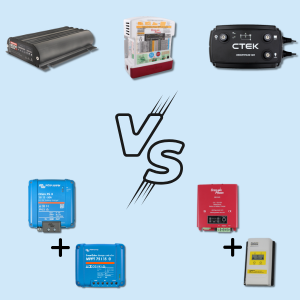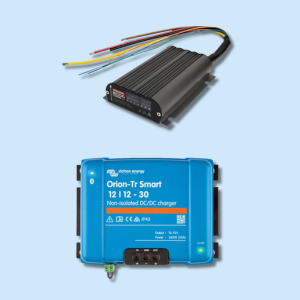Choosing Between A 2-In-1 Charger Or Separate MPPT and DC-DC Chargers
So, you're at the point with your electrics where you are looking at chargers and you're wondering whether to get a 2-in-1 charger (MPPT and DC-DC charger combined) or a separate DC-DC charger and MPPT controller. Which route should you take?
Here are some of the pros and cons with the 2-in-1 battery chargers that we have available on our website:
Pros:
- 2-in-1 chargers take up less space in a build than having two separate chargers and this can be very advantageous, especially when you are pushed for space in your campervan, boat or other off-grid project.
- You only have to buy one unit so it is usually cheaper than buying two separate units. This is one of the top reasons that 2-in-1 battery charger systems are so popular, and have been ever since they entered the market.
- You only have one unit to cable up and learn how to operate, so it can be easier to install & setup than two separate units. You also usually end up using less cable, which saves you even more money and space in the build and simplifies the installation.
Cons:
- All MPPT controllers have a limit to how much Open Circuit Voltage they can handle from a solar panel. Unfortunately, most 2-in-1 chargers have an Open Circuit Voltage limit that is significantly lower than that of a standalone MPPT controller. For example, the CTEK D250SE is 23V, the Sterling Power BBS1230 is 31V, and the REDARC BCDC CORE 25A is 32V, whereas even the smallest standalone controllers are around 60-70V. If you exceed the MPPT controller's Open Circuit Voltage limit it can lead to damage of the controller that will not be covered under the warranty. The solar panels that we stock have Open Circuit Voltages of 21V+, but some solar panels on the market are 38V and higher, so make sure you check the Open Circuit Voltage of your panel before purchasing an MPPT controller (or choose a panel that has a low enough voltage to suit your controller).
- If you have a 2-in-1 unit and one part of it fails (not common, but it can happen), for example, the MPPT controller, we would need the whole unit back to be tested by the manufacturer under warranty and you would then be left without either charging source. So having two separate chargers can be good from a redundancy point of view, so that if one fails you still have the other to keep your batteries topped up while the failed unit is being tested by the manufacturer.
We hope this helps you make an informed decision about which system would be best for you. We are in no way trying to dissuade customers from purchasing 2-in-1 battery charger systems, but it's important to understand the advantages and disadvantages before committing.
If you have any questions regarding this article or anything else in your electrical system, send us an email to sales@12voltplanet.co.uk and we will be happy to help.


